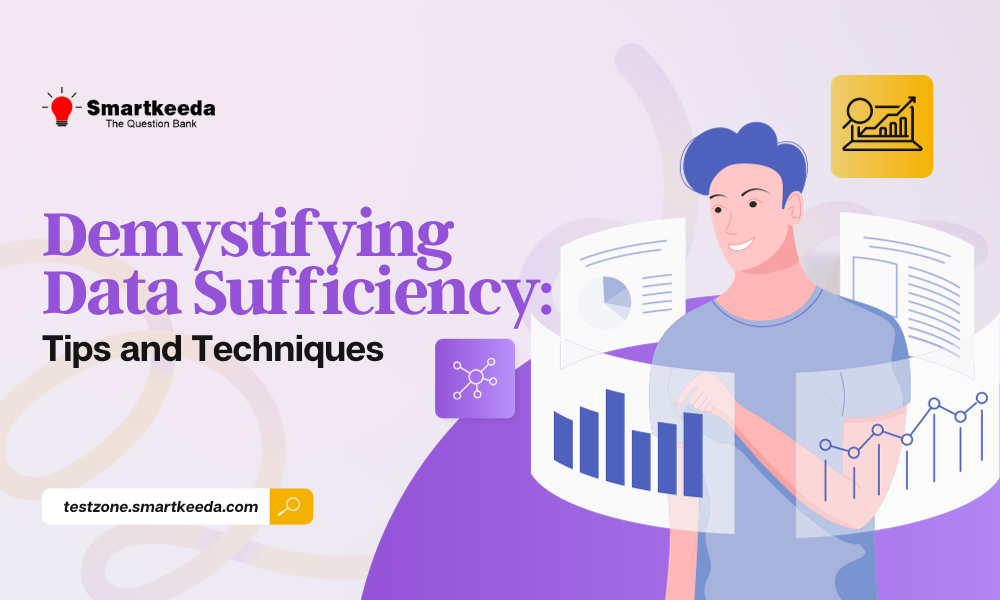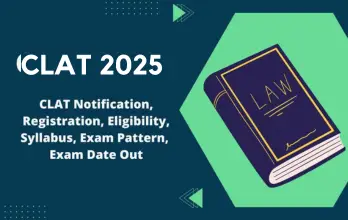
Now, if you're new to the bank exam and wondering what Data Sufficiency is, how to solve these questions, and the best strategies for handling them during the exam, this blog will clear up all your doubts and give you a solid understanding.
Data Sufficiency is a crucial part of bank exams, mainly in the mains but sometimes even in the prelims. Mastering this topic is important if you want to do well in banking exams. These questions are part of the reasoning and math sections, which are super important in these exams.
In a Data Sufficiency question, you get a problem to solve.
- It starts with a question
- followed by 2-3 sentences with info
- Your job is to actively decide if the info in these statements, either alone or when combined, gives you a complete answer to the question.
- If you find that all the info in the statements isn't enough to answer the question, you should choose the answer that says, "Statements 1 and 2 together are not sufficient."
Why Data Sufficiency Matters
But that's when Data Sufficiency comes to your rescue. If you practice Data Sufficiency well and have a good grip on miscellaneous concepts, you can score well in the exam. In bank mains exams, you can almost be sure that there will be 4 to 6 Data Sufficiency questions.
Sometimes, the importance of Data Sufficiency even shows up in bank PO prelims, although the questions are not too hard at that level. All these reasons add up to why mastering Data Sufficiency is so crucial and why it matters. It can make a big difference in your exam performance.
The Data Sufficiency Question Format
To excel in this type of question, you need a clear grasp of the Data Sufficiency (DS) question format, its components, and the common answer choices. Let's delve deeper into this for a better understanding.
Components of a Data Sufficiency Question
Data Sufficiency Question:
This part comprises the question you need to answer. Typically, these questions are from topics within reasoning and quantitative aptitude. Your task is to ascertain whether the information given in the statements is enough to answer the question.
Statements:
You are given two or sometimes three statements, named statement 1, statement 2, and statement 3. Your responsibility is to analyze the question, interpret the provided data, and determine whether the data in these statements, either individually or when combined, is sufficient to reach a conclusion. Based on your analysis, you must select an answer.
Answer Choices:
Upon reviewing the question and statements, you must select one of the following options:
a. Statement 1 alone is sufficient: Choose this option when the data in statement 1 alone provides enough information to answer the question without requiring the other statements.
b. Statement 2 alone is sufficient: Opt for this choice when the data in statement 2 alone is sufficient to answer the question without relying on other statements.
c. Both statements together are sufficient, but neither statement alone is sufficient: Select this option when you need to take the data from both statements to reach a conclusion. Neither of the statements alone provides enough information to answer the question.
d. Each statement alone is sufficient: This option applies when the data in each statement, taken independently, is capable of providing enough information to address the question.
e. Statements 1 and 2 together are not sufficient: If, even after considering both statements together, you still cannot answer the question, mark this option.
Effective Strategies for Achieving Success in Data Sufficiency
A Step-by-Step Approach:
- Start your data sufficiency problem solving by carefully reading the question. Understand precisely what the question is asking.
- Next, dissect each statement individually. Determine whether each statement on its own provides sufficient information to accurately answer the question.
- In cases where neither statement alone proves adequate, consider combining both statements. However, ensure that the combined statements present unique data, avoiding repetition of previously known facts.
- Avoid the temptation to make unwarranted assumptions or infuse your knowledge into the problem. Your responses should be rooted in the data provided within the questions and statements.
- While working through "data sufficiency aptitude problems" during the exam, exercise prudent time management. It is imperative to allocate your time efficiently to ensure you can complete the entire test within the designated time frame.
- Mastery of this subject can be attained through consistent practice of data-sufficiency questions. Regular practice helps build confidence and proficiency in tackling such problems.
Common Pitfalls to Avoid:
- Approach each question with care, and avoid making hasty conclusions without thoroughly assessing every statement. It's crucial to prioritize considering all relevant information before selecting your answer.
- Don't rush through the questions and accidentally miss options like "both statements together are sufficient." These choices often lead to the correct answer, so be sure to pay attention to them.
- Sometimes, the information may seem incomplete at first glance, but with a careful analysis and interpretation of the statements, you can find the correct answer. Therefore, be diligent when examining the statements.
- Always remember that the exam consists of many questions, and efficient time management is essential.
- Avoid spending too much time on a single question; instead, strike a balance to ensure you can address all questions within the allocated time.
- These are common pitfalls to be aware of and avoid when dealing with data sufficiency questions. By following these effective strategies and being mindful of these potential pitfalls, you can enhance your performance in data sufficiency questions, ultimately improving your overall exam scores.
Classifying Data Sufficiency Problems
Data Sufficiency Problems represent a common and essential component of bank exams like IBPS PO and SBI PO. To excel in this area, it is vital to have a strong grasp of different types of DS questions and to be proficient in answering them effectively. These problems can be broadly categorized into two key segments: Reasoning Data Sufficiency and Quantitative Data Sufficiency.
In Reasoning Data Sufficiency, a high level of competence is required across various topics such as coding-decoding, puzzles, seating arrangements, blood relations, and directions. Occasionally, questions may also involve topics like syllogism and inequality. Achieving proficiency in these diverse reasoning topics is crucial to succeed in this section.
As for Quantitative Data Sufficiency, it mirrors Reasoning in structure, but the questions predominantly revolve around mathematical subjects, particularly arithmetic concepts. A strong command of arithmetic principles is necessary to confidently address Quantitative Data Sufficiency questions. Regular practice is a must in developing this proficiency, enabling you to navigate these questions with ease and precision.
Data Sufficiency Techniques
Using Statements Independently
The initial step in solving Data Sufficiency (DS) questions is to assess whether the data provided in each statement alone is sufficient to answer the question. Here's a closer look at the right approach to this process:
- Carefully read and comprehend the information given in each statement. Ensure you understand each detail.
- After reviewing each statement, you need to decide: does the statement provide enough data independently to arrive at an answer?
- If the answer is yes, you can confidently mark the respective option. However, if the statement doesn't offer enough data on its own, go to the next statement.
- In cases where both statements independently don't yield a conclusive answer, it becomes necessary to explore the potential of combining both statements.
Combining Statements Effectively
When both statements fail to provide the necessary data to reach a definitive conclusion, as discussed earlier, the option of combining the information from both statements comes into play. When combining statements, there are some essential rules to keep in mind:
- Begin by identifying and marking the relevant information about the question from both statements.
- Look for data that may overlap or repeat, as this overlapping information is often the key to finding the desired answers.
- Apply logical reasoning to figure out how each piece of data contributes to answering the question.
- Finally, explore various possibilities and decide whether the combined data leads to a conclusive answer.
- If you can arrive at an answer after combining both statements, mark the appropriate option. However, if combining the statements still doesn't provide a clear answer, select the response indicating "both statements together are not sufficient to answer."
Benefits of conducting Data Sufficiency topic test
- Solving topic tests offers a valuable opportunity for focused practice on a specific topic, contributing to a more efficient and profound mastery of the topic.
- Consistently solving data sufficiency topic tests not only helps you improve your speed but also enhances the accuracy with which you approach and solve questions.
- These tests provide a comprehensive overview of your current level of command over the subject and provide insight into your strengths and areas in need of further development.
- Through a thorough analysis of the test results, you can pinpoint specific areas that require improvement, allowing for a more targeted and effective approach to boosting your performance.
- Solving Data Sufficiency topic tests not only enhances your mathematical skills but also imparts essential time management abilities, which play a key role during actual examinations.
- Actively experimenting with various test-taking strategies during these practice tests enables you to refine your approach, ultimately leading to a notable enhancement in your overall test scores.
- The exposure to the exam environment that topic tests provide can significantly reduce anxiety, making you feel more at ease and confident during the actual test day.

Author : Amrish
Hi, this is Amrish, an Assistant Manager in one of the largest private banks with an extensive background in the banking industry. Having post-graduated with honors in Finance from a renowned university, I embarked on a rewarding career in the financial services industry. With a deep understanding of their unique needs and goals for banking exams, I would love to help aspirants through my blogs. I will keep sharing insights for cracking various exams by providing tips, strategies, mistakes one should avoid, the best resources, and much more. God Speed to all aspirants!
FAQ’s
In Data Sufficiency, you do not have to solve a question to find the right answer; instead, your task is to determine whether the provided data is sufficient to answer the question.
DS is difficult topic or accuracy is unlikely, also remember that assuming all data is relevant, relying on institutional knowledge, or making random guesses can still earn you some marks these are some of the common misconceptions that should be aware of.
Sometime, you may not find an answer even when combining both statements. In such instances, avoid attempting to solve the question again; instead, mark this option and proceed to the next question.
No specific resources exist; practice from reputable books, coaching study materials, mock tests, and topic tests for improved results in Data Sufficiency.
When combining statements to arrive at an answer, it is crucial to consider various scenarios and conditions. In such situations, your logical reasoning plays a vital role.
Understand the question, identify keywords like "only," "at least," "all," "none," "if," or "whether," and check for conditional statements and interdependencies to quickly spot constraints in DS questions.





